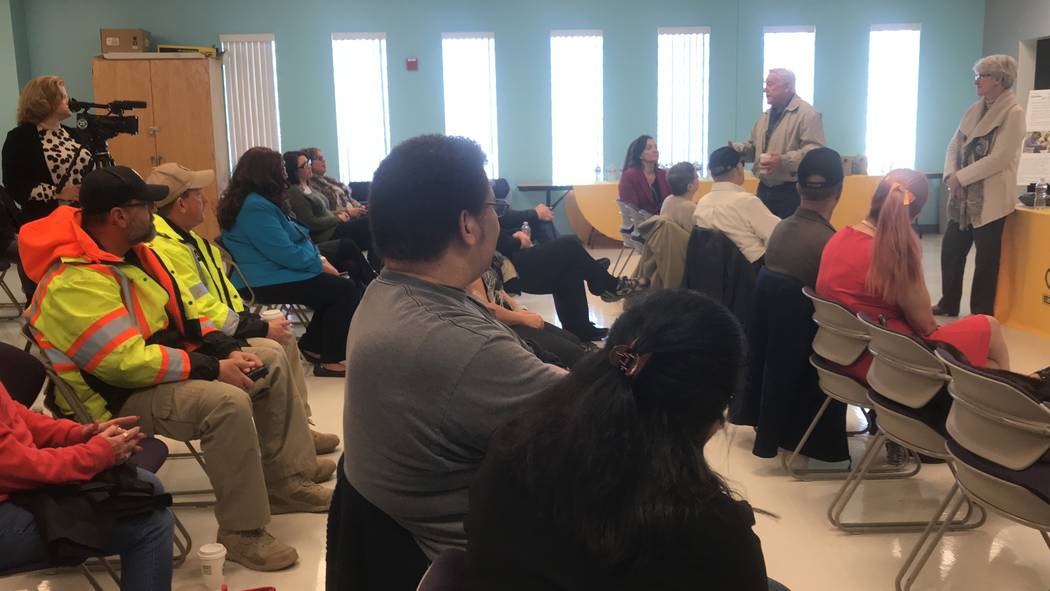
Great Basin College President Joyce Helens painted the financial picture of the college and forward-looking thoughts during a town hall meeting at the Pahrump campus in February.
The meeting brought out roughly two dozen leaders in the local community along with area residents who wanted to express their thoughts on the future of the institution.
Helens engaged these community members during a roughly 90-minute-long discussion on where the college stands while listening to community members and their needs in an open discussion at the campus adjacent to Pahrump Valley High School at 551 E. Calvada Blvd. Helens talked about changes in the funding formula for higher education and how it has affected the college along with other financial impacts the school has felt.
Helens said a big bump in enrollment occurred in the fall semester at the college due to two infusions in funding.
One of those infusions was from a College and Career Readiness grant.
Helens explained that that grant goes with the Nye County School District “so we have dual enrollment—and that’s where a high school student sitting there is also able to get credit for a college degree.”
“The other one we had. There’s something called Silver State Grant that comes from our state,” she said. “Other colleges didn’t use all of theirs, and we were able to get approximately $500,000 of what wasn’t used.”
Helens said the school had an 18 percent increase in their FTE (full-time equivalent students) in the fall.
The current student count at the Pahrump campus now sits at over 500, she reported during the meeting.
“Of course, we’re asking for both those amounts of money again, so we can make sure that we can allow those students to continue,” she said. “Because just getting them in, I feel like if they can’t complete, if they can’t persist, then we’re doing them a disservice.”
Other funding sources have not been as favorable for Great Basin.
A new funding formula was introduced for higher education institutions in the state some years prior, Helens explained.
Under this new formula, the college has been cut $1.4 million in funding, Helens said.
The recession did also take a toll on the school overall.
Great Basin moved into its Pahrump location in 2006. The building it occupies once housed a College of Southern Nevada location.
“We lost 86 full-time positions during the recession,” she said. “That’s about a third of the workforce.”
The school has gained back 12 of those positions, according to Helens.
Helens said the formula will not be discussed at this session but is hopeful that it will be re-evaluated at the next legislative session.
“But in the meantime, we can’t just hope,” she said. “We have to really say what can we do to be proactive?”
Going forward, there won’t be any cutting because there’s nothing left to cut, she said.
“It really has to be a tightening, a restructuring, looking at growth strategies and collaboration,” she said.
That collaboration could involve College of Southern Nevada.
“And as we saw today, having College of Southern Nevada here, that has resources that we don’t have, and they’re so close, that if we need a program here that they have, there’s nothing wrong with them having it here,” she said.
The Pahrump branch of Great Basin has been growing over the past several years.
“Last year, we had commencement exercises here because we had over 40 graduates,” Helens said.
Helens also spoke about the potential for a new campus in the future for the Pahrump area.
According to a September 2016 article in the Pahrump Valley Times, the Nevada Board of Regents approved a conveyance of 274 acres of land from the Bureau of Land Management to Great Basin for Great Basin’s campus.
“The land is located on the southeast end of town, near Carpenter Canyon Road and Highway 160,” the article stated.
Helens envisions an idea of shared services for a new campus.
“You know how you see industrial parks?” she said. “So you have a big piece of land, and you’ll have different kind of businesses or companies. I’ve always liked the idea of a kind of educational park, where you can have shared services, where someone is not telling you wait until you get to a population base of this before you can have all that.”
Helens continued, saying, “I’m thinking what if we had UNLV, CSN? What if we had those kind of shared services …? What if that could be on this campus, shared services, as well as business and industry? What if we had, for instance, a community library, but it was right here?”
“We don’t have to build everything ourselves and wait until two decades go by before we can ever afford it,” she said. “If we can share services with others, then we can have that happen here quicker.”
Contact reporter Jeffrey Meehan at jmeehan@pvtimes.com